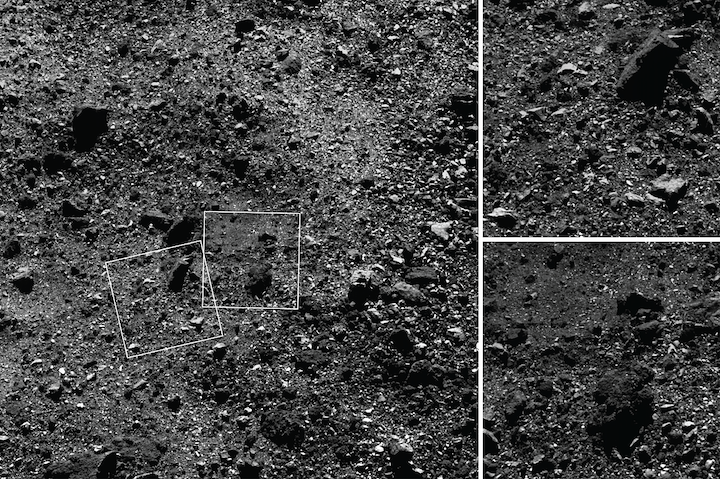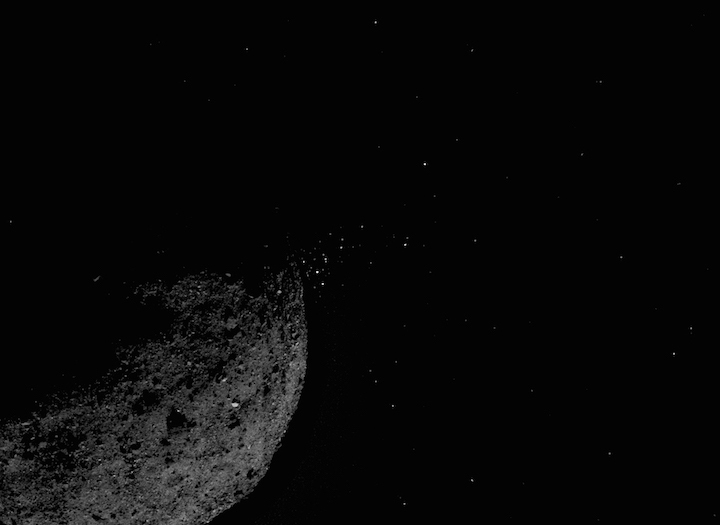14.12.2018
NASA's OSIRIS-REx Prepares for New Year's Eve Date with Asteroid Bennu
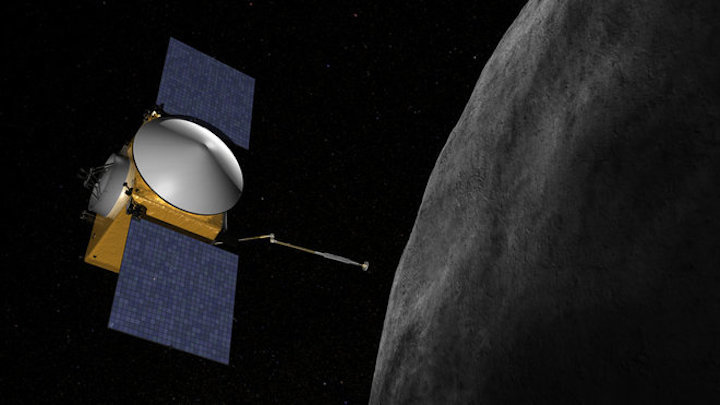
WASHINGTON — 2018 has been quite a year for spaceflight, but it's not over yet, and the OSIRIS-REx mission has one more major task to accomplish before the ball drops: slipping into orbit around the near-Earth asteroid Bennu.
The team will tackle that maneuver sometime on the afternoon of Dec. 31, but there's a lot to do before the feat can take place. Two tasks in particular will occupy the OSIRIS-REx team for the rest of the month: conducting a detailed survey of their asteroid target, and plotting precisely how the spacecraft will execute the orbital insertion.
"The navigation team's gonna check all their numbers, make sure that the maneuvers all work and then they're going to design the approach back to the asteroid," Dante Lauretta, principal investigator for OSIRIS-REx, told Space.com during the annual meeting of the American Geophysical Union. The team won't know precisely when the orbital insertion maneuver will take place until about 24 hours beforehand. [In the Clean Room: Up-Close Look at NASA's Asteroid-Sampling Probe OSIRIS-REx]
But before it enters orbit around the tiny body, the OSIRIS-REx spacecraft has an unusual amount of freedom in flight. "I call it like a hummingbird," Lauretta said. "When you're in microgravity, your concept of orbital dynamics goes out the door — you can change planes, you can leave orbit, you can re-enter orbit. You can do all these things that if you were in Mars orbit you would never be able to do."
The OSIRIS-REx team is taking advantage of that freedom by conducting a detailed survey of the asteroid. The spacecraft has made three close passes over the north pole of the space rock. On Sunday (Dec. 9), it turned toward the equator, and yesterday (Dec. 11), it settled into flight around that belt. Next, it will head down to the south pole.
All told, that tour will produce five estimates of Bennu's mass — a critical factor for establishing an orbital insertion trajectory — and the most detailed data to date about mineralogy in the region.
"The geology is phenomenal, it's been the greatest week of my career," Lauretta said. "We're all gathered around our monitors, we're pulling up the data, people are saying, 'Hey, look at this,' you come running over to see this feature that they've just looked at — so there's going to be a lot more of that going on for sure." Lauretta added that so far, the team has only looked at about 30 percent of the asteroid's surface in much detail.
While he's conscious of just how much work needs to get done between now and insertion, Lauretta said he's pleased with everything that's happened so far and excited for the Dec. 31 maneuver.
"The spacecraft is very well-behaved, so we're confident on everything we've seen so far that we'll be able to go with the nominal design," Lauretta said. "But again, they're going to triple-check it just to make sure we got everything right."
Quelle: SC
----
Update: 15.12.2018
.
First Images from OSIRIS REx Mission Have Scientists Buzzing with Excitement
Arecibo Observatory in Puerto Rico plays a role in OSIRIS REx mission planning.
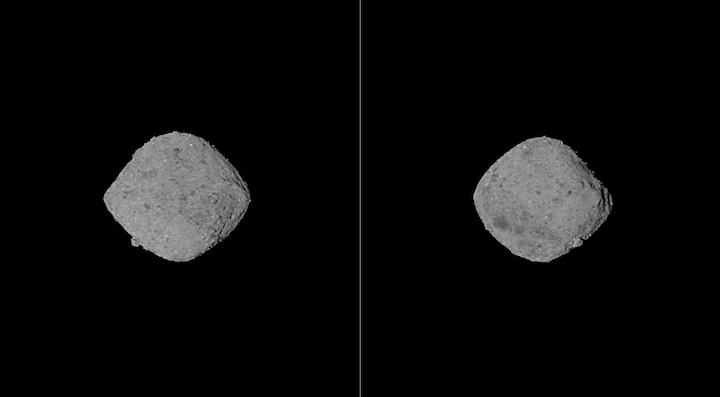
The holidays came early for the science team leading NASA’s OSIRIS-REx mission to collect samples from a near-Earth asteroid. Today they announced findings from the mission thus far, which arrived at asteroid Bennu Dec. 3
Scientists were already buzzing with excitement in November when the spacecraft’s long-range cameras began beaming early images of the asteroid. Now, the first few close ups confirm the buzz.
“The images are spectacular and spot on … it is pretty amazing to actually see [the Bennu asteroid] now.” – Humberto Campins, UCF professor
“We’re very excited,” says Humberto Campins, a University of Central Florida planetary scientist, professor of physicsand member of the OSIRIS-REx Science Team. He and UCF Associate Professor Yan Fernandez are part of the team that will analyze close range images of the asteroid to recommend the best spot to collect the sample. “The images are spectacular and spot on, what we expected thanks to predictions made with the instrumentation at the Arecibo Observatory in the late 90s and early 2000s. We will spend a year and a half mapping Bennu and have to wait until mid 2020 we collect the sample, but it is pretty amazing to actually see it now. Christmas came early.”

UCF Professor of physics Humberto Campins works on the OSIRIS REx Mission.
The mission’s lead scientists from the University of Arizona and other institutions presented initial results about the asteroid and the mission at the AGU conference in Washington D.C. today. The AGU is the largest worldwide conference in Earth and space sciences and was expected to host more than 20,000 attendees this year, including representatives from the Arecibo Observatory.
“The amazing Bennu images coming out now look strikingly similar to the shape model derived from Arecibo radar data in 2013,” says Anne Virkki, a research scientist at observatory in Puerto Rico.
Bennu was discovered in 1999, and shortly after, Arecibo’s radar and the Goldstone planetary radar system were used to examine it. In 2005 Arecibo was used to complete a second set of radar observations. In 2013, a team of scientists led by Michael Nolan (who now works for the OSIRIS-REx mission as asteroid scientist and science team chief), published Bennu’s shape model and pole orientation, based on the radar data from 1999 and 2005. The Arecibo radar team also predicted Bennu’s size and rotation period and the team detected a distinctive boulder on the asteroid’s surface.
OSIRIS-REx launched from the Space Coast in 2016. The early images from OSIRIS-REx dramatically confirm that those predictions were accurate, scientists say.
“No other ground-based method is capable of detecting such features,” Virkki says from the facility.

Anne Virkki is a research scientist at the Arecibo Observatory.
Arecibo director Francisco Cordova, who attended the conference, was thrilled to see another example of the facility helping advance space science.
“This only demonstrates what everyone at Arecibo already knows,” Cordova says. “Our facility is a tremendous resource to the world, which continues to contribute to important discoveries, across multiple science communities. The best is yet to come for the observatory, which will be receiving significant upgrades over the next four years including new receivers, feeds and transmission capabilities.”
Campins agrees. He says the work done at Arecibo was invaluable in NASA’s selection of the OSIRIS-REx project for full funding when it was competing with a dozen other proposals in NASA’s New Frontiers Program.
UCF operates the Arecibo Observatory in partnership with Sistema Ana G. Mendez Universidad Metropolitana and Yang Enterprises Inc., under a cooperative agreement with the National Science Foundation. The planetary radar program is supported by NASA’s Near Earth Object Observation Program.
“The information obtained from radar characterization of this asteroid at Arecibo was critical in mission target selection and supported OSIRIS-REx science definition and mission planning,” Campins says. “Arecibo’s radar data gave us two main advantages. It minimized the uncertainty in the shape of the asteroid and its orbit, which help reduce risk and increase the likelihood of a successful mission.”
Quelle: University of Central Florida
----
Update: 31.12.2018
.
OSIRIS-REx Debuts New Bennu Mosaic, 3D Shape Model

This mosaic image of asteroid Bennu is composed of 12 PolyCam images collected on Dec. 2 by the OSIRIS-REx spacecraft from a range of 15 miles (24 km).
Credit: NASA/Goddard/University of Arizona
Quelle: NASA
+++
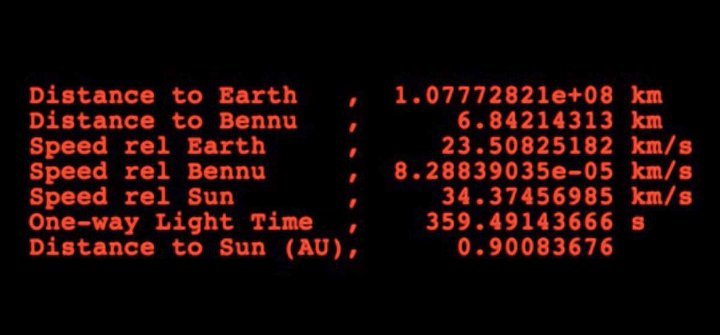
OSIRISREx has now crossed closer to Bennu than ever before: 4.4 miles (7km) and closing on orbit insertion target.
Quelle: NASA
----
Update: 1.01.2019
.
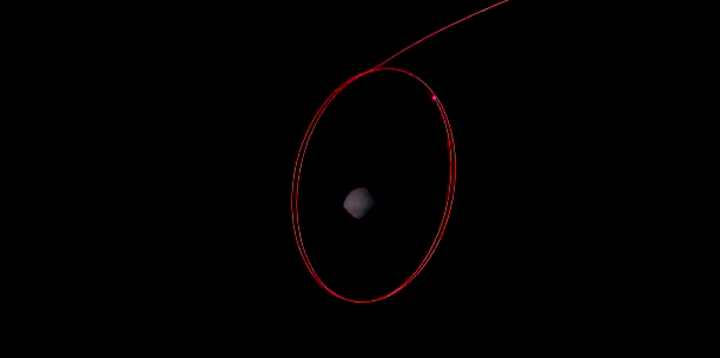
It's official! I'm in orbit around #asteroid Bennu -- now the smallest body ever orbited by a spacecraft. My snug path around the asteroid also sets a new record for the closest orbit of a planetary body by any spacecraft.
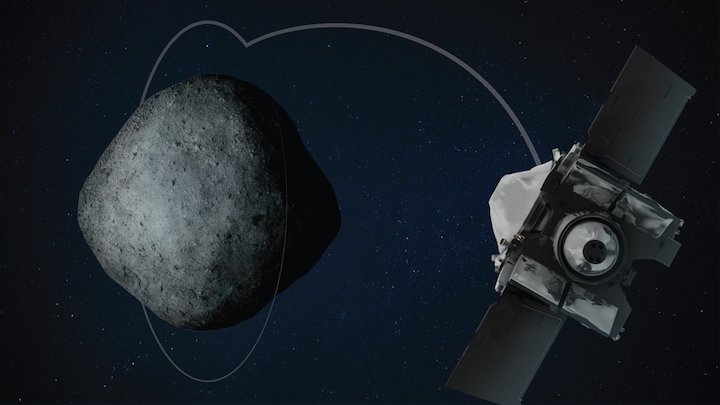
Quelle: NASA
----
Update: 6.01.2019
.

NavCam Image of Earth, the Moon, and Bennu
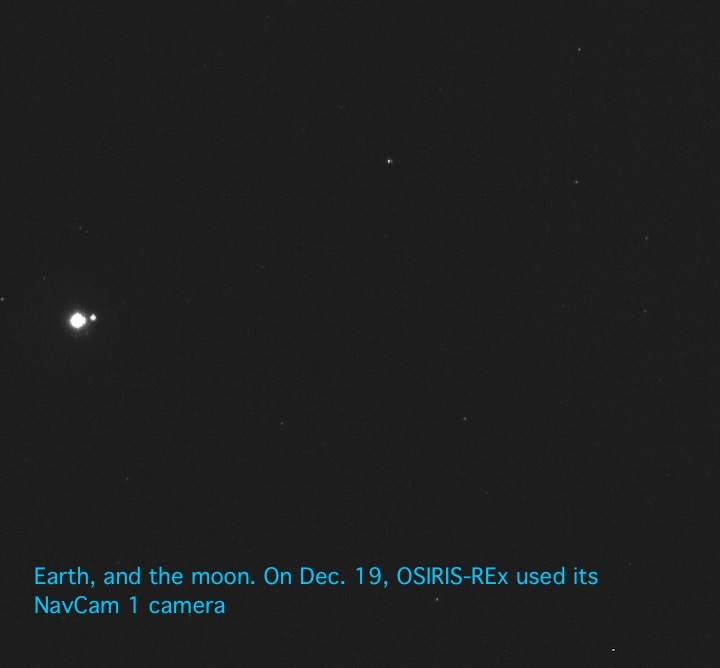
On Dec. 19, OSIRIS-REx used its NavCam 1 camera to capture this image of three familiar planetary bodies: asteroid Bennu, Earth, and the moon. Despite the spacecraft’s distance from home – about 71 million miles (114 million kilometers) – Earth and the Moon are visible in the lower left due to the long exposure time used for this image (five seconds). The spacecraft’s range to Bennu is only about 27 miles (43 kilometers), so the asteroid appears highly overexposed in the upper right. The head of the constellation Hydra is also visible in the lower right portion of the image.
NavCam 1 is a black-and-white imager that is one of three cameras comprising TAGCAMS (the Touch-and-Go Camera System), which is part of OSIRIS-REx’s guidance, navigation, and control system. TAGCAMS was designed, built and tested by Malin Space Science Systems; Lockheed Martin Space integrated TAGCAMS to the OSIRIS-REx spacecraft and operates TAGCAMS.
Quelle: NASA
----
Update: 17.01.2019
.
Mapping an asteroid requires views from all directions. During Preliminary Survey, I used MapCam to snap this image of Bennu from a distance of about 8 miles (13 km) as I flew toward the asteroid during a pass over its equator. http://bit.ly/2QT8Rlp :
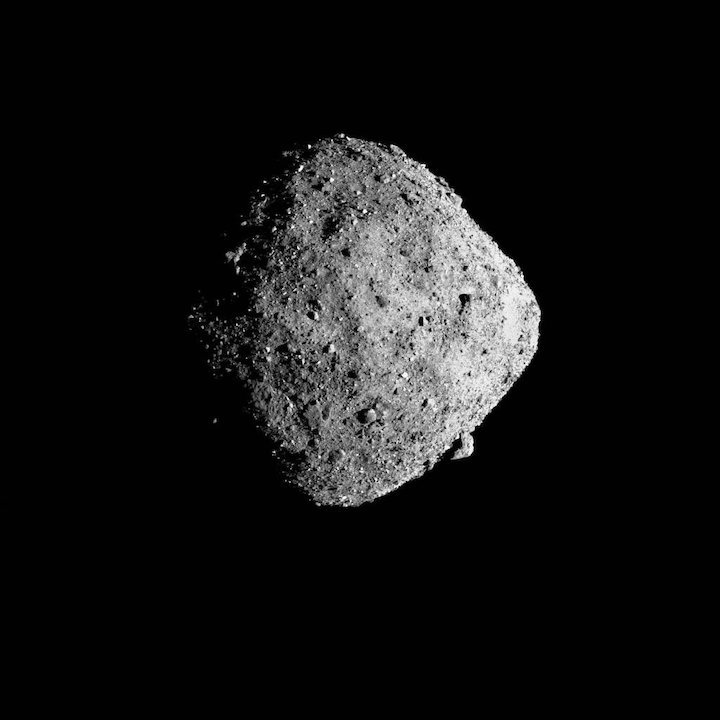
Quelle: NASA
----
Update: 30.01.2019
.
NASA Probe Snaps 1st Photos from Just a Mile Above Asteroid Bennu and the View's AMAZING!
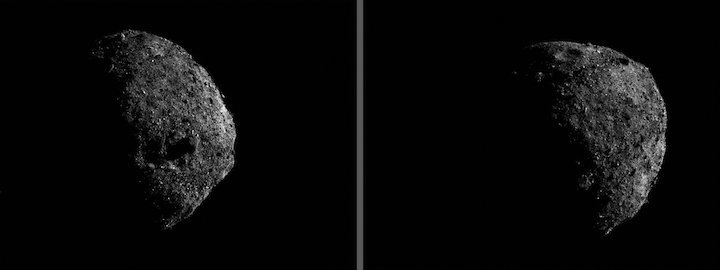
Credit: NASA/Goddard/University of Arizona/Lockheed Martin
NASA's OSIRIS-REx mission is orbiting an asteroid closer than any spacecraft has ever orbited a body — and it shows in an incredible pair of photographs that the team released yesterday (Jan. 24).
The spacecraft slipped into orbit around the asteroid, called Bennu, on Dec. 31, after the team carefully mapped the object to design a safe path for the probe. That was a challenge, since Bennu is the smallest space rock that's ever been orbited.
But the dangerous maneuver has paid off. OSIRIS-REx is orbiting just about 1 mile (1.6 kilometers) above Bennu's surface, giving its cameras an incredible view of the asteroid's rocky surface. Scientists believe that rugged shape is the result of Bennu having formed from a bunch of rubble loosely clumped together.
The two images shown here were taken by an instrument called NavCam, which is the main camera the team uses to steer the spacecraft. The images, snapped on Jan. 17, show Bennu's south pole.
Another recently released image of the south pole of Bennu, taken while the spacecraft was preparing for orbit, was captured at a distance of about 8 miles (12 km) but still gives scientists a detailed view of the surface topography.

Credit: NASA/Goddard/University of Arizona
This photo was captured by a different camera on the spacecraft, called MapCam, which is one of the probe's science instruments rather than a dedicated navigation camera. Its main purpose is to photograph the asteroid in color and help the team select where it will collect a sample to bring home to Earth for analysis.
The sampling process won't begin until mid-2020, after the team has had plenty of time to study Bennu from all angles and make an informed decision about where to collect the sample — informed in part by detailed observations of the surface boulders that could interfere with sampling equipment.
Quelle: SC
----
1.02.2019
.
OSIRIS-REx finds rugged terrain on asteroid Bennu
Some time next year, NASA’s OSIRIS-REx spacecraft will descend to the boulder-strewn surface of asteroid Bennu, reach out with a robotic arm, and fetch a sample for return to Earth, but an initial survey of the space rock millions of miles from Earth suggests the robotic mission may have few suitable targets for the touch-and-go maneuver.
OSIRIS-REx is still in the early weeks of its stay at asteroid Bennu, a roughly 1,640-foot-wide (500-meter) object that oscillates inside and outside of Earth’s orbit on each trip around the sun. Bennu’s proximity to Earth, which makes it an impact risk to the planet in the distant future, allowed ground-based radars to scan the asteroid in detail, revealing its size and shape before OSIRIS-REx’s launch in 2016.
The radar observations made by stations at Arecibo, Puerto Rico, and Goldstone, California, did a “phenomenal job of predicting the shape and topography of the asteroid for us,” said Dante Lauretta, principal investigator for the $1 billion Origins, Spectral Interpretation, Resource Identification, Security, Regolith Explorer mission at the University of Arizona, Tucson.
On its approach to the asteroid last year, OSIRIS-REx showed Bennu is shaped like diamond, or a spinning top, just as the radar observations suggested.
“It’s really good news that we got it so right, and that all our mission design plans are valid as we move forward,” Lauretta said Wednesday at a meeting of NASA’s Small Bodies Assessment Group, a community of scientists with research interests in asteroids, comets and other small objects in the solar system.
“We do have the expected, so-called ‘spinning top’ shape, which seems to be characteristic of a subset of the near-Earth asteroid population,” Lauretta said.
“One of the reasons we think it’s top-shaped is because it’s been accelerated by thermal pressures to sort of spin up,” said Olivier Barnouin, a co-investigator on the OSIRIS-REx mission from the Johns Hopkins University Applied Physics Laboratory. “You can imagine if you take a top and start spinning up, if you have little rocks on it, things might go flying off.”
OSIRIS-REx’s cameras searched for evidence of moons or debris around Bennu late last year.
“We can confirm, to this point, that we have not identified any rocks that are flying around, and that there’s no risk to the spacecraft, which actually I think is kind of remarkable because this place is very dynamic,” Barnouin said in a Dec. 31 presentation of the mission’s preliminary findings at Bennu.
But Bennu did present some surprises to scientists, such as its jagged, craggy terrain covered with a collection of boulders, rock piles, craters and ridges.
“Some of the things that jump out at us right away from the asteroid’s surface are the large boulders,” Lauretta said Wednesday. “We are a looking at a pretty rough and rugged surface, more so than we expected.”
The first detailed images from OSIRIS-REx suggest Bennu exhibits the scars from collisions with other objects in the solar system, perhaps when Bennu orbited in the main asteroid belt between the orbits of Mars and Jupiter. The basins include up to a dozen large impact craters that measure up to 500 feet (150 meters) in diameter, according to Lauretta.
“We’re thinking that the asteroid surface’s cratering age may be older than we expected, and may record its collisional history in the main asteroid belt,” he said.
Scientists believe the asteroid’s visible surface may be between 100 million and 1 billion years old, and Lauretta says Bennu is likely a “rubble pile” asteroid, made by the merging of several distinct objects. With the data already returned by OSIRIS-REx, scientists have calculated Bennu has a bulk density just 20 percent higher than that of water, and a bit less than that of Jupiter.
Officials marked OSIRIS-REx’s arrival at Bennu on Dec. 3, when the spacecraft flew over the asteroid’s north pole. Subsequent passes over both poles and the equator allowed scientists to calculate the asteroid’s mass, a crucial parameter for planning the probe’s future trajectories.
OSIRIS-REx is currently in the mission’s “Orbital A” phase, following a maneuver Dec. 31 that directed the spacecraft into a slow-speed loop around Bennu that ranges between 1 mile and 1.3 miles (1.6 to 2.1 kilometers) from the asteroid. Due to Bennu’s weak gravity field, thousands of times weaker than that of Earth, OSIRIS-REx travels at a speed of just one-tenth of a mile per hour, or 5 centimeters per second, relative to the asteroid.
The orbital velocity of satellites circling the Earth can be as high as 17,500 mph (7.8 kilometers per second).
OSIRIS-REx has set records, becoming the first mission to orbit an object as small as Bennu, and as the closest any spacecraft has orbited to any planetary body.
The craft’s navigation team on Earth is plotting the location of landmarks and other prominent features on the asteroid’s surface. Beginning next month, OSIRIS-REx will fly on station-to-station trajectories around the asteroid, pulsing its thrusters to cover Bennu globally and periodically move to closer and farther distances.
“The orbit phase is not really a science campaign phase,” Lauretta said. “It’s primarily there for the navigation team to transition from using star fields to landmarks on the asteroid surface. That transition is going very well, and are achieving navigation accuracies that are required for us to depart orbit in about four weeks and begin the detailed survey campaign of the mission.”
When the solar system formed more than 4.5 billion years ago, chunks of rock and ice collided as they circled the sun like the balls on a billiard table, eventually building up planets. The leftovers became asteroids and comets, and scientists believe Bennu still harbors the basic carbon-bearing organic molecules that were present in the early solar solar system, the stuff that may have helped seed life.
The spacecraft carries three cameras — one for long-range viewing, a color camera for mapping, and another imager to take pictures as OSIRIS-REx collects samples from the asteroid’s surface. The rest of OSIRIS-REx’s suite of science instruments includes a thermal emission spectrometer to detect heat coming from the asteroid, a visible infrared spectrometer to locate minerals and organic materials, a laser altimeter provided by the Canadian Space Agency to create topographic maps, and a student-built X-ray spectrometer to identify individual chemical elements present on the asteroid.
Data gathered by thermal emission and visible infrared spectrometer instruments — OTES and OVIRS — indicates clay minerals on the asteroid’s surface contain hydroxyl molecules with oxygen and hydrogen molecules bonded together. This finding suggests Bennu’s surface was once in contact with water, likely when the asteroid was part of a much larger parent body that was smashed to bits in a collision in the chaotic early solar system.
One prominent feature of Bennu’s landscape is a large boulder protruding from the surface near the south pole. While ground-based radar images suggested the boulder to be at least 33 feet, or 10 meters, in height, OSIRIS-REx imagery indicates is closer to 164 feet, or 50 meters, tall with a width of approximately 180 feet, or 55 meters, according to NASA.
On approach to Bennu, ground controllers at Lockheed Martin in Denver — where OSIRIS-REx was built — unlatched the probe’s robotic arm from its launch restraint for the first time. Over several days, the ground team commanded the arm to bend its joints and jettison a launch cover over the sample collection mechanism, which will release compressed air during a touch-and-go maneuver to force gravel and surface material into an on-board chamber for the journey back to Earth.
One of the darkest features spotted so far on Bennu appears to be rich in magnetite and iron oxide, Lauretta said, based on early spectral measurements from OSIRIS-REx’s instruments. Scientists are intrigued by the darker regions of the asteroid because they are expected to contain more carbon, the scientific pay dirt for the sample return mission.
But officials will evaluate where OSIRIS-REx can safely reach the surface in the coming months, with the tough-and-go descent currently scheduled for July 4, 2020. That can be pushed back a few months, if necessary, before the spacecraft must depart Bennu in March 2021 to reach Earth in September 2023.
“The OSIRIS-REx mission’s sample site selection campaign starts next month, which is when we will start receiving science data at the resolution needed to make informed assessments about the safety of various regions on Bennu,” Lauretta said in a written response Thursday to questions from Spaceflight Now.
“We’re thinking about sampling the surface … and the craters are starting to look as possibly good candidates because they’re fairly smooth in structure, as far as we can tell at this point in the mission,” Barnouin said.
Quelle: SN
----
Update: 13.03.2019
.
ASTEROID BENNU, TARGET OF NASA’S SAMPLE RETURN MISSION, IS ROTATING FASTER OVER TIME
WASHINGTON — In late 2018, the Origins, Spectral Interpretation, Resource Identification, Security-Regolith Explorer (OSIRIS-REx) spacecraft arrived at Bennu, the asteroid it will be studying and sampling over the next several years.
Now, new research in the AGU journal Geophysical Research Letters shows Bennu is spinning faster over time – an observation that will help scientists understand the evolution of asteroids, their potential threat to Earth and if they could be mined for resources.
Bennu is 110 million kilometers (70 million miles) away from Earth. As it moves through space at about 101,000 kilometers per hour (63,000 miles per hour), it also spins, completing a full rotation every 4.3 hours.
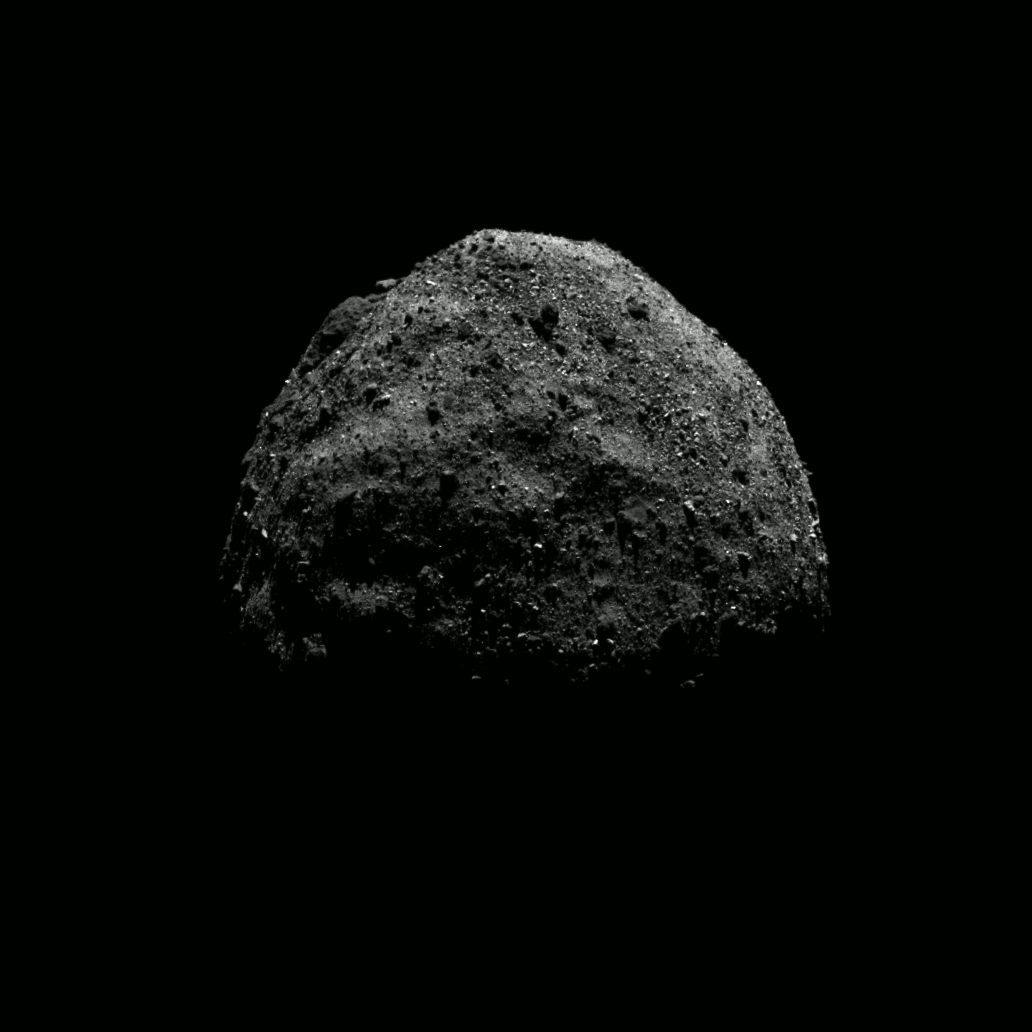
This series of MapCam images was taken over the course of about four hours and 19 minutes on Dec. 4, 2018, as OSIRIS-REx made its first pass over Bennu’s north pole. The images were captured as the spacecraft was inbound toward Bennu, shortly before its closest approach of the asteroid’s pole. As the asteroid rotates and grows larger in the field of view, the range to the center of Bennu shrinks from about 7.1 to 5.8 miles (11.4 to 9.3 km).
This first pass was one of five flyovers of Bennu’s poles and equator that OSIRIS-REx conducted during its Preliminary Survey of the asteroid.
Credit: NASA/Goddard/University of Arizona
The new research finds the asteroid’s rotation is speeding up by about 1 second per century. In other words, Bennu’s rotation period is getting shorter by about 1 second every 100 years.
While the increase in rotation might not seem like much, over a long period of time it can translate into dramatic changes in the space rock. As the asteroid spins faster and faster over millions of years, it could lose pieces of itself or blow itself apart, according to the study’s authors.
Detecting the increase in rotation helps scientists understand the types of changes that could have happened on Bennu, like landslides or other long-term changes, that the OSIRIS-REx mission will look for.
“As it speeds up, things ought to change, and so we’re going to be looking for those things and detecting this speed up gives us some clues as to the kinds of things we should be looking for,” said Mike Nolan, a senior research scientist at the Lunar and Planetary Laboratory at the University of Arizona in Tucson, who is the lead author of the new paper and the head of the OSIRIS-REx mission’s science team. “We should be looking for evidence that something was different in the fairly recent past and it’s conceivable things may be changing as we go.”
The OSIRIS-REx mission is scheduled to bring a sample of Bennu to Earth in 2023. Understanding Bennu’s rotational change could help scientists figure out what asteroids can tell us about the origin of the solar system, how likely it is for asteroids to pose a threat to humans and if they could be mined for resources.
“If you want to do any of those things, you need to know what is affecting it,” Nolan said.
Detecting a change
In order to understand Bennu’s rotation, scientists studied data of the asteroid taken from Earth in 1999 and 2005, along with data taken by the Hubble Space Telescope in 2012. It was when they looked at the Hubble data that they noticed the rotation speed of the asteroid in 2012 didn’t quite match their predictions based on the earlier data.
“You couldn’t make all three of them fit quite right,” Nolan said. “That was when we came up with this idea that it had to be accelerating.”
The idea that the rotation of asteroids could speed up over time was first predicted around 2000 and first detected in 2007, according to Nolan. To date, this acceleration has only been detected in a handful of asteroids, he said.
The change in Bennu’s rotation could be due to a change in its shape. Similar to how ice skaters speed up as they pull in their arms, an asteroid could speed up as it loses material.
Nolan and his co-authors suggest the reason for the increase in Bennu’s rotation is more likely due to a phenomenon known the YORP effect. Sunlight hitting the asteroid is reflected back into space. The change in the direction of the light coming in and going out pushes on the asteroid and can cause it to spin faster or slower, depending on its shape and rotation.
The OSIRIS-REx mission will determine Bennu’s rotation rate independently this year, which will help scientists nail down the reason for the increase in rotation. Since spacecraft will never visit the vast majority of asteroids, the measurements will also help scientists learn how well ground-based measurements are able to understand these far-away objects.
“By testing these predictions in a few cases, we will significantly improve our confidence in predictions made for other objects,” the study’s authors write.
The measurement of Bennu’s acceleration rate combined with the arrival of OSIRIS-REx at the asteroid gives scientists a great opportunity to validate the new study’s results and test theories about the YORP effect, said Desiree Cotto-Figueroa, an assistant professor of physics and electronics at the University of Puerto Rico at Humacao, who was not involved in the new study.
“This is a great opportunity, in general, having this measurement and having the spacecraft OSIRIS-REx there observing this asteroid to help us better understand this effect, which is a dominant mechanism in the evolution of asteroids,” she said.
Quelle: AGU
----
Update: 15.03.2019
.
Quelle: NASA
----
Update: 19.03.2019
.
apan’s Hayabusa 2 mission, which is exploring another asteroid named Ryugu, faced a similar challenge after it arrived at its target last year. Japanese managers found Ryugu was also covered in coarse, rocky material, forcing officials to delay Hayabusa 2’s first touch-and-go landing from last year until February.
Hayabusa 2’s engineers devised a way to get the spacecraft to Ryugu’s surface under tighter constraints the originally planned, aiming for a smaller sampling location wedged between surrounding boulders. The spacecraft successfully gathered a sample from Ryugu on Feb. 21, and is set to return to Earth at the end of 2020.
Lauretta said a contingent of OSIRIS-REx’s team will travel to Japan next month to learn from Hayabusa 2’s experience.
“We feel confident that our systems and our teams are up to the task of tagging to a sample collection site of much smaller area than was previously envisioned,” Burns said.
Quelle: SN
----
Update: 21.03.2019
.
Surprising astronomers, Bennu spits plumes of dust into space
It’s the first time astronomers have seen such activity on an asteroid
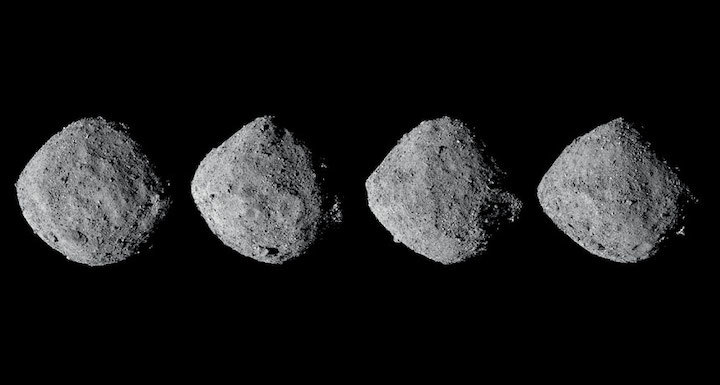
BOULDERY BENNU Near-Earth asteroid Bennu (shown in multiple views from the OSIRIS-REx spacecraft) surprisingly erupts plumes of dust from its rocky surface.
THE WOODLANDS, Texas — Like the “Peanuts” character Pigpen, the near-Earth asteroid Bennu moves around in a cloud of its own dust.
NASA’s OSIRIS-REx spacecraft has watched Bennu spit out plumes of dust 11 times since the spacecraft arrived at the asteroid in December 2018. And some of that dust is caught in orbit around the asteroid, scientists announced March 19 at the Lunar and Planetary Science Conference. It’s the first time astronomers have spotted such activity at an asteroid.
“Definitely we did not expect to see this,” said OSIRIS-REx principal investigator Dante Lauretta of the University of Arizona in Tucson. “We are probably seeing a new kind of activity at asteroid Bennu.”
While this result has planetary scientists excited, the overall news from Bennu is mixed. OSIRIS-REx’s primary mission is to collect dust from the asteroid in 2020 and bring it back to Earth in 2023, in hopes that the rubbly, water-rich asteroid holds clues to the origin of life in the solar system (SN: 1/19/19, p. 20). But that job may prove tricky. In a series of studies in Nature journals released March 19, the OSIRIS-REx team reports that the space rock is a minefield of boulders much bigger than the craft was designed to navigate.
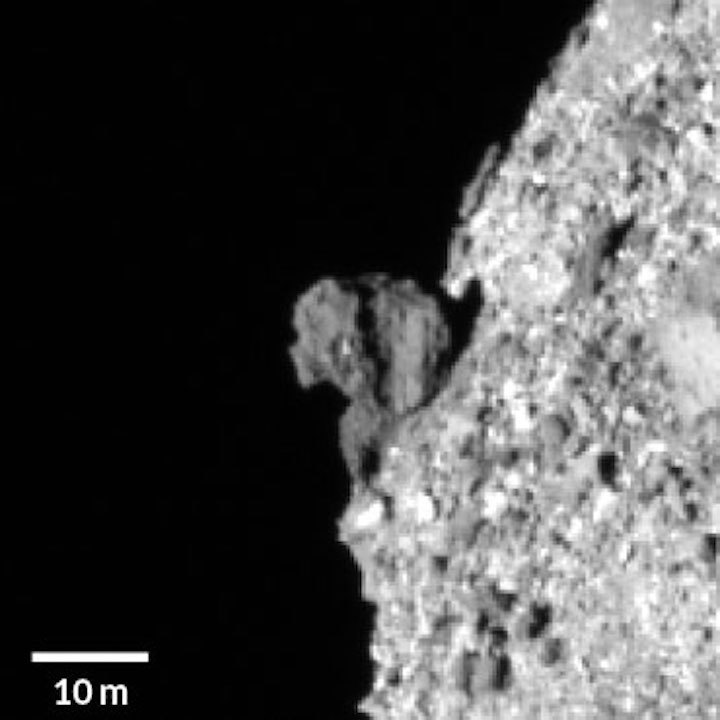
ROCKY SENTINEL The OSIRIS-REx team nicknamed this large boulder “the gargoyle.” Bennu has more than 200 of these big, hazardous rocks strewn across its surface.
“It’s not necessarily completely unexpected,” says planetary scientist Daniella DellaGiustina, also of the University of Arizona. “But it does pose a harder challenge than we had planned for.”
OSIRIS-REx arrived at the near-Earth asteroid on December 3, when the rock was about 130 million kilometers away from Earth (SN Online: 12/3/18). To the team’s surprise, OSIRIS-REx’s navigation cameras picked up several bright spots floating near the asteroid on January 6.
Analyzing the spots revealed that they were eruptions of dust particles from Bennu’s surface. The particles were ejected at speeds between a few centimeters per second and 3 meters per second. Some of the dust is flying off into space, but some is getting caught in orbit around Bennu, Lauretta said. The team saw 11 separate plumes from January 6 to February 18.
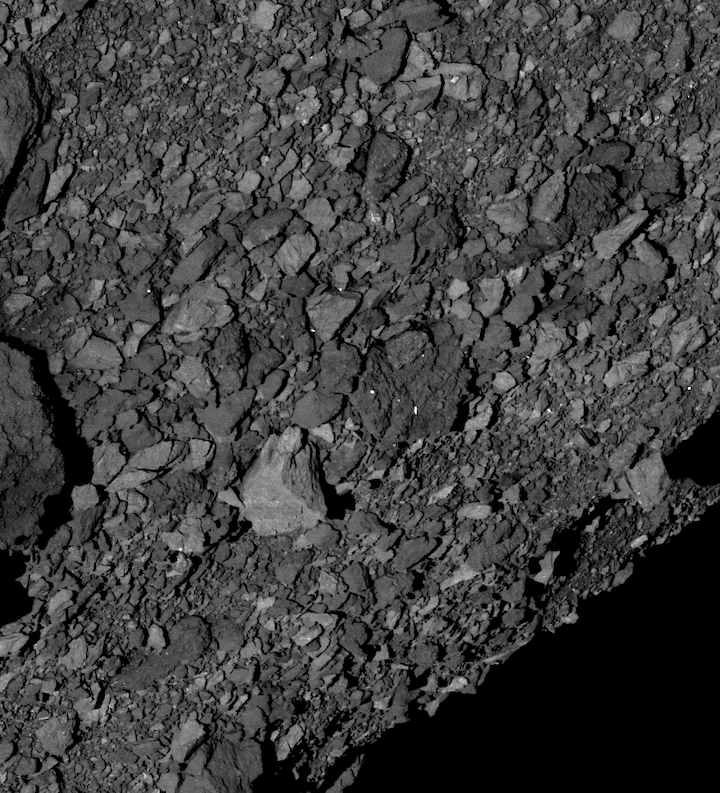
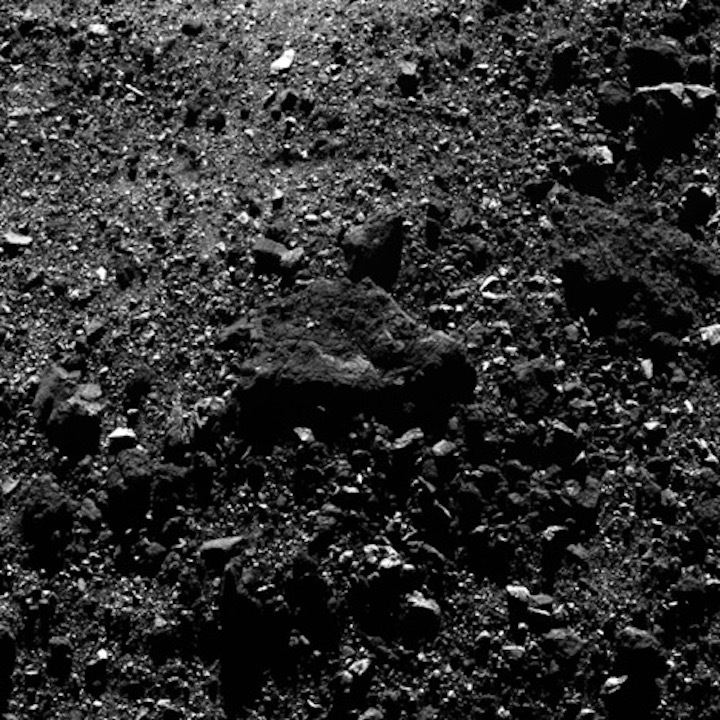
“I’m amazed,” says planetary scientist William McKinnon of Washington University in St. Louis, who is not part of the OSIRIS-REx team. “I’ve never heard of this before. That’s the coolest thing so far.”
Lauretta and colleagues aren’t sure what causes the plumes. One idea is that Bennu’s subsurface contains volatile gases, which escape from the rock as the sun heats them up and push out plumes of dust in the process. If so, Bennu may have reached near-Earth space relatively recently, though it’s unclear exactly when. Because the asteroid was likely born further from the sun in the asteroid belt between Mars and Jupiter, it probably would have lost those volatiles had it wandered into the inner solar system a long time ago, the scientists say.
The team doesn’t think that the dust poses a danger to the spacecraft. But Bennu’s surface might.
The plan was for the craft to briefly land in a region at least 50 meters wide, where a vacuumlike instrument would collect dust no larger than 2 centimeters across. But there are no clear regions that are wide enough on Bennu’s surface. Most of the asteroid is a boulder field, and the widest areas of small, sandy particles span just 20 meters. The team is working on adjusting its plans to successfully grab the goods from a smaller area.
“We do have sampleable material on this asteroid,” DellaGiustina says. “It’s not a wonderful sandy asteroid full of these centimeter-scale particles that we were hoping for, but it is a workable situation.”
Another asteroid sample return mission may offer more hope. The Japanese Hayabusa2 mission is also exploring a boulder-covered asteroid, called Ryugu. And Hayabusa2 seems to have taken a sample of material on February 21 (SN Online: 2/22/19). “That gives us a lot of confidence,” DellaGiustina says. The OSIRIS-REx team is planning to meet with the Hayabusa2 team to see what lessons can be learned.
Quelle: ScienceNews



